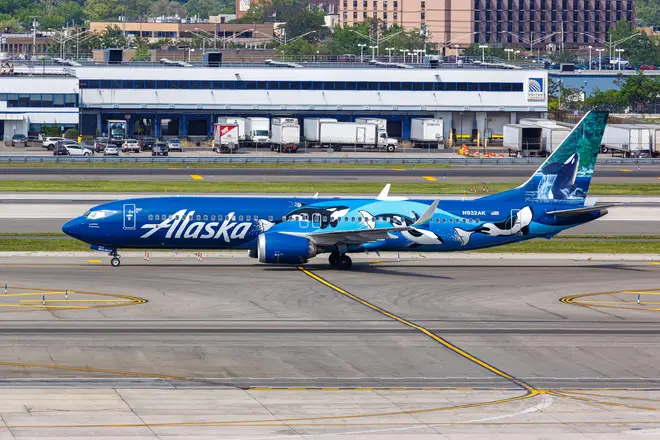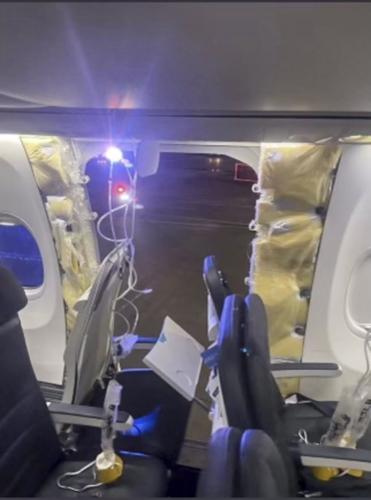NEWS WIRES
Sat, 6 January 2024

© Ted S. Warren, AP
U.S. regulators have ordered the temporary grounding of 171 Boeing 737 MAX 9 aircraft following a cabin panel blowout late Friday that forced a brand-new airplane operated by Alaska Airlines to make an emergency landing.
“The FAA is requiring immediate inspections of certain Boeing 737 MAX 9 planes before they can return to flight,” FAA Administrator Mike Whitaker said on Saturday. “Safety will continue to drive our decision-making as we assist the NTSB’s investigation into Alaska Airlines Flight 1282.”
The piece of fuselage tore off the left side of the jet as it climbed out of Portland, Oregon, en route for Ontario in California on Friday, forcing pilots to turn back and land safely with 171 passengers and six crew on board.
The new MAX 9 had been in service for just eight weeks. It is the latest mishap involving Boeing's best-selling model, which was grounded for almost two years following crashes in 2018 and 2019, and comes as Boeing and a major supplier are grappling with a succession of production or quality problems.
There were no immediate indications of the cause of the apparent structural failure, nor any reports of injuries. Alaska Airlines had alreaady started grounding dozens of the Boeing jets for safety checks.
As of Saturday morning, Alaska said it had completed more than a quarter of the inspections and found no issues. Several of the jets were flying, according to tracking site FlightRadar24.
Alaska Airline CEO Ben Minicucci said in a statement its fleet of 65 similar planes would be returned to service only after precautionary maintenance and safety inspections, which he expected to be completed in the "next few days."
Alaska Airlines midair window blowout:
Alaska Airlines grounds all Boeing 737-9 aircraft after emergency landing due to blown out window.

Alaska Airlines grounded all of its Boeing 737 Max 9 aircraft late Friday after a window and a portion of the plane's fuselage blew out shortly after take-off in Portland, Oregon, US.
After the mid-air window blowout, the airline made an emergency landing in Portland, Oregon. Luckily, no one was hurt during the incident. The airline company announced to temporarily ground all of its planes for thorough maintenance and safety inspections.
Also Read: DGCA orders one-time inspection of emergency exits on all Boeing 737-8 Max aircraft
This is not the first time when Boeing 737 Max 9 aircraft have been grounded by an airline for safety concerns. The narrow-body airplane has often landed Boeing in trouble even in the past. In 2018 and 2019, two Boeing 737 Max 8 jets crashed killing 346 people. The accidents resulted in a nearly two-year worldwide grounding of all Max 8 and Max 9 planes. Boeing managed to bring back its planes to service only after making changes to an automated flight control system implicated in the crashes. Despite, all these difficulties, the Boeing 737 Max continues to be one of the most successful aeroplane series of the company. Here’s all you need to know about the aircraft.
Boeing 737 Max 9
Boeing 737 Max 9 is one of the variants of Boeing 737 Max. The aircraft is based on the early designs of the 737 and is more efficient than its predecessors. Its four variants vary based on seating capacity, size, and length. Boeing 737 Max 9 has a seating capacity of178 – 193 with a seating capacity of 220 seats. It is 42.16 metre long with a wing span of 35.9 m, which is the same in all the variants.
Also Read: 90% of air passengers allege compromised comfort, cost-cutting by Indian airlines over last 2 years, says survey

View Full ImageBoeing 737 Max is manufactured in four variants based on their size and seating capacity. (Boeing)
Boeing 737 Max: When it was launched?
The Boeing 737 Max series was announced in August 2011. Five years later, the company's first Boeing 737 Max aeroplane took its maiden flight on January 29, 2016, and was certified by the United States Federal Aviation Administration (FAA) in March 2017. The first delivery of Max 8 was done in May 2017 to Malindo Air, which marked the commencement of Boeing 737 Max service.
Also Read: Aviation industry aims for growth with sharp focus on supply in 2024
Boeing 737 Max: Features
The aeroplane provides an optimised aerodynamic design which includes advanced technology winglets to increase effective wingspan. This technology also helps in the reduction of fuel use and emissions. Its flight deck features four large displays to enable additional operational capability, including a larger map that increases crews’ situational awareness.
Also Read: Delhi-bound Indigo flight returns to Patna airport due to technical snag
Boeing 737 Max: Orders and deliveries
According to Boeing's official website, the company received a total of 1383 orders for Boeing 737 Max between 2022-23. Till now, the company has received a total of 7,502 orders for 737 Max (including all four variants of the plane). In 2023, the aeroplane manufacturer delivered a total of 343 737 Max aircraft (including all four variants), out of which three were delivered to India's Air India airlines.
Do Indian airlines operate Boeing 737 Max 9 aircraft?
At present none of the Indian airlines operate a Boeing 737 Max 9 aircraft as part of their fleet, according to a press release issued by the Directorate General of Civil Aviation (DGCA) on Saturday. In its release, the DGCA ordered all the Indian airlines to immediately carry out a one-time inspection of the emergency exits on all Boeing 737-8 Max aircraft currently operating as part of their fleet.
"Pursuant to the Alaska Airlines incident involving Boeing 737-9 Max aircraft, there have been no inputs or guidance from Boeing so far. None of the Indian air operators have a Boeing 737-9 Max as part of their fleet yet. However, as an abundant precautionary measure, DGCA has directed all the Indian air operators to carry out a one-time inspection of the emergency exits immediately on all Boeing 737-8 Max aircraft currently operating as part of their fleet," DGCA said in a post on X.
US grounds Boeing 737 Max 9 planes after Alaska Airlines flight loses part of fuselage at 16,000ft
6 January 2024,

The US aviation regulator has grounded 171 Boeing 737 Max 9 planes after part of an Alaska Airlines flight's fuselage fell off at 16,000ft on Friday.
The Federal Aviation Authority (FAA) says it will inspect 171 in response to the shocking scenes yesterday evening.
Passengers have described how a child had to be held to his seat by his mother as part of a plane's fuselage blew out, leaving a gaping hole in the aircraft.
Travellers were left horrified after the incident forced the Alaska Airlines Boeing 737-9 to turn around at 16,000ft and return to Portland International Airport in Oregon.
Footage taken onboard shows passengers anxiously wait for the emergency landing as they breathe into oxygen masks, with the cabin having depressurised.
They tell each other it was lucky nobody had sat next to the part that blew out.
The Association of Flight Attendants at Alaska Airlines described the decompression was "explosive".
One passenger told Portland news station KPTV that a mother held her child to his seat.
Phones were sucked out of the plane, while a child near to the blow-out lost his shirt as the cabin depressurised.
A huge hole can be seen in the left hand side of the fuselage.
Kyle Rinker told CNN: "It was really abrupt. Just got to altitude, and the window/wall just popped off and didn't notice it until the oxygen masks came off."
Vi Nguyen told the New York Times she woke up to see an oxygen mask dangling in front of her.
"And I look to the left and the wall on the side of the plane is gone. The first thing I thought was, 'I'm going to die'," she said.
"A part of the plane flew off not even 20 minutes into our flight," said one person who posted the terror on TikTok.
Read more:
The pilot told air traffic control that there was an emergency, and the plane had depressurised and needed to come back.
All 174 passengers and six crew members were safe, though one crew member was slightly injured, and Alaska Airlines has grounded its 737-9 fleet.
Read more:
Ben Minicucci, the chief executive of Alaska Airlines, said: "Following tonight's event on Flight 1282, we have decided to take the precautionary step of temporarily grounding our fleet of 65 Boeing 737-9 aircraft."
The aircraft will be brought back into use after repairs and safety inspections, which are expected to last just days.
The US National Transportation Safety Board said it was looking into what happened, as did the Federal Aviation Administration (FAA).

The Boeing 737-9 Max was certified two months ago and has flown 145 times since mid November.
The model is the newest version of the 737.
All Max 8 and Max 9 planes were grounded for two years after two Max 8s crashed in 2018 and 2019, killing more than 300 people.
Boeing had to make changes to the automated flight control system before they were put back into service.
The company said it was gathering more information about what happened in this incident.
"We are aware of the incident involving Alaska Airlines Flight 1282," it said.
"We are working to gather more information and are in contact with our airline customer.
"A Boeing technical team stands ready to support the investigation."
In December, it told airlines to inspect planes for a potential loose bolt in the rudder control system.
And last year, the FAA urged pilots to limit their use of an anti-ice system because of fears that inlets near the engines could over heat, break away and hit the plane.

